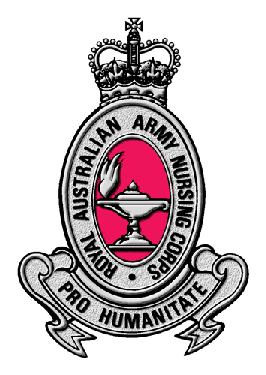Royal Australian Army Nursing Corps
== Royal Australian Army Nursing Corps ==
The Royal Australian Army Nursing Corps (RAANC) is a vital component of the Australian Army that provides nursing services to military personnel. Established in 1902, the RAANC has a long and distinguished history of serving in various conflicts and peacekeeping missions around the world.
History[edit | edit source]
The RAANC traces its origins back to the early 20th century when it was officially formed in 1902. Since its inception, the corps has played a crucial role in providing medical care to Australian soldiers during times of war and peace. Over the years, members of the RAANC have demonstrated exceptional skill, dedication, and compassion in their service to the Australian Defence Force.
During World War I, nurses from the RAANC served in various theaters of war, tending to the wounded and providing comfort in challenging conditions. Their contributions were widely recognized and appreciated by the soldiers they cared for.
In World War II, the RAANC once again proved its value by providing essential medical support to Australian troops deployed in different parts of the world. The courage and professionalism displayed by the corps during this conflict further solidified its reputation as a vital component of the Australian military.
Role and Responsibilities[edit | edit source]
The primary role of the RAANC is to provide nursing care to military personnel across a wide range of settings, including field hospitals, military bases, and deployment zones. Nurses in the corps are trained to handle a variety of medical situations, from routine healthcare to emergency trauma care.
In addition to their clinical duties, members of the RAANC also play a crucial role in promoting health and wellness within the military community. They educate soldiers on preventive health measures, conduct health screenings, and support overall readiness and resilience among military personnel.
Training and Qualifications[edit | edit source]
To join the RAANC, individuals must meet specific educational and training requirements. Prospective nurses undergo rigorous training that prepares them for the unique challenges of military nursing. They receive instruction in areas such as battlefield medicine, triage, and emergency response.
Upon completion of their training, nurses in the RAANC are equipped to provide high-quality care in a variety of environments, including combat zones and humanitarian missions. Their skills and expertise are essential in ensuring the health and well-being of Australian soldiers in all circumstances.
Legacy and Recognition[edit | edit source]
The contributions of the RAANC have been widely recognized and honored over the years. The courage, dedication, and sacrifice of the nurses in the corps have left a lasting legacy within the Australian military and beyond. Their commitment to caring for others in times of need exemplifies the highest ideals of nursing and military service.
The RAANC continues to uphold its tradition of excellence and service, remaining a cornerstone of the Australian Army's healthcare system. Through their unwavering commitment to duty and compassion for others, the nurses of the RAANC embody the values of professionalism, integrity, and selflessness that define the corps.
Search WikiMD
Ad.Tired of being Overweight? Try W8MD's physician weight loss program.
Semaglutide (Ozempic / Wegovy and Tirzepatide (Mounjaro / Zepbound) available.
Advertise on WikiMD
|
WikiMD's Wellness Encyclopedia |
| Let Food Be Thy Medicine Medicine Thy Food - Hippocrates |
Translate this page: - East Asian
中文,
日本,
한국어,
South Asian
हिन्दी,
தமிழ்,
తెలుగు,
Urdu,
ಕನ್ನಡ,
Southeast Asian
Indonesian,
Vietnamese,
Thai,
မြန်မာဘာသာ,
বাংলা
European
español,
Deutsch,
français,
Greek,
português do Brasil,
polski,
română,
русский,
Nederlands,
norsk,
svenska,
suomi,
Italian
Middle Eastern & African
عربى,
Turkish,
Persian,
Hebrew,
Afrikaans,
isiZulu,
Kiswahili,
Other
Bulgarian,
Hungarian,
Czech,
Swedish,
മലയാളം,
मराठी,
ਪੰਜਾਬੀ,
ગુજરાતી,
Portuguese,
Ukrainian
Medical Disclaimer: WikiMD is not a substitute for professional medical advice. The information on WikiMD is provided as an information resource only, may be incorrect, outdated or misleading, and is not to be used or relied on for any diagnostic or treatment purposes. Please consult your health care provider before making any healthcare decisions or for guidance about a specific medical condition. WikiMD expressly disclaims responsibility, and shall have no liability, for any damages, loss, injury, or liability whatsoever suffered as a result of your reliance on the information contained in this site. By visiting this site you agree to the foregoing terms and conditions, which may from time to time be changed or supplemented by WikiMD. If you do not agree to the foregoing terms and conditions, you should not enter or use this site. See full disclaimer.
Credits:Most images are courtesy of Wikimedia commons, and templates Wikipedia, licensed under CC BY SA or similar.
Contributors: Prab R. Tumpati, MD

